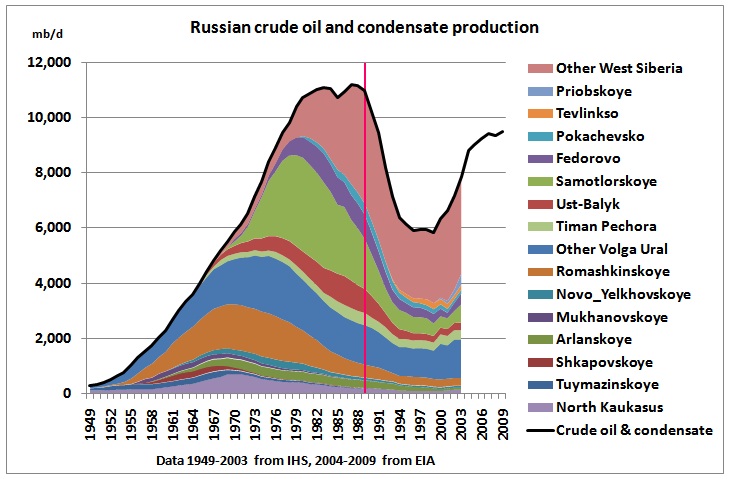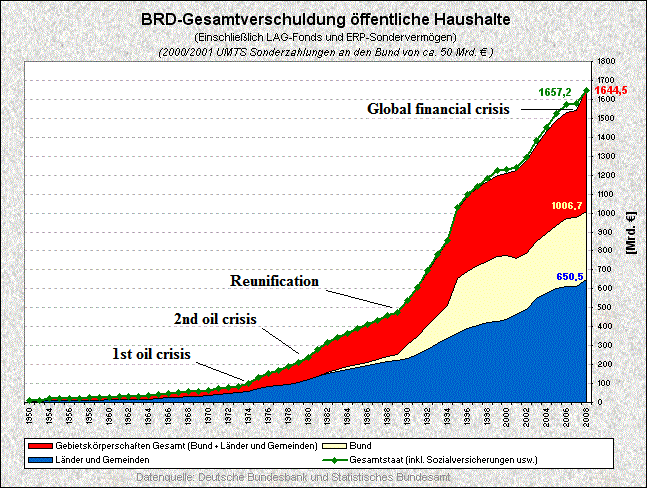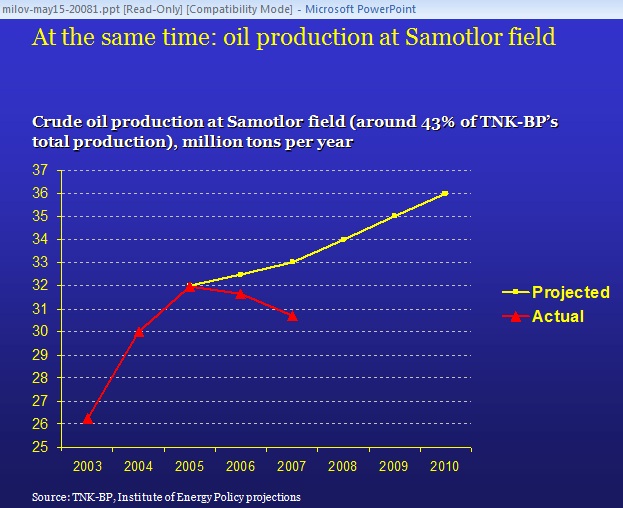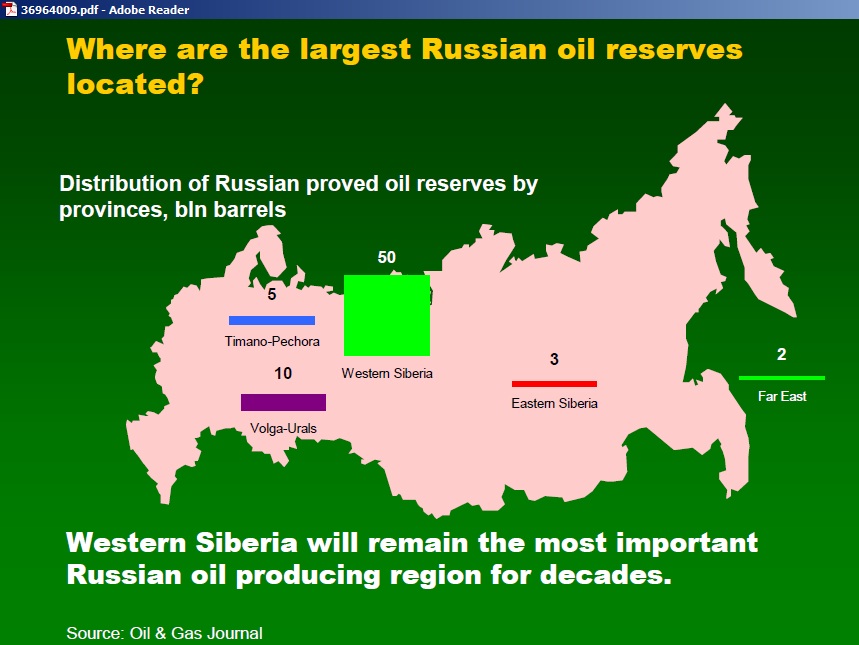On the 20th anniversary of German reunification the Spiegel sums up the events in 1990 in this series of articles:
An Inside Look at the Reunification Negotiations
http://www.spiegel.de/international/germany/germany-s-unlikely-diplomatic-triumph-an-inside-look-at-the-reunification-negotiations-a-719848.html
Of interest to us now is how the peaking of Russian oil production impacted on the events in 1990, which was also the year of Saddam Hussein’s invasion in Kuwait (August 1990). We had a convergence of many events, just like today as the global peak is happening. It is important to learn the lessons of the past. It seems that current governments – who still do business as usual and allow new airports and freeways to be built – are still not aware of what consequences peak oil events can have and that they have to prepare for what is coming.
It can be clearly seen that well before 1989 a steep decline in the giant oil fields Romashkinskoye and Samotlor could not be offset by production from other oil fields which caused a serious oil crisis. It was one of the contributing factors to the collapse of the Soviet Union.
From the Spiegel article:
Gorbachev, as Genscher [the German Minister for Foreign Affairs participating in negotiations] observed at the time, “is only interested in what is happening at the moment.” And at that moment, there was turmoil throughout the Soviet Union, whose ethnic groups were striving for independence. “What can I do?” Gorbachev said at the time. “Azerbaijan and Lithuania, radical reformers on the one hand, social democrats on the other, and the blows are getting more and more painful, the economy is limping along, and the people are running out of energy.”
How did it come to this energy crisis?
This is a description from the book “The FSU in transition”
Then Michael Gorbachev came to power and promised a new deal: glasnost (openness) and perestroika (restructuring). Gorbachev visited the West Siberia oil region in September 1985. His visit resulted in the early retirement of a number of oil industry managers and party bosses. He stated: “It has now become clear that the time of golden gushers, of easy oil is coming to an end. It is necessary to switch to forced extraction of oil, to move to more difficult areas with fields providing lower yields and to develop more complex deposits”….Oil output from West Siberia increased twice as fast as total output, the region accounting for 2/3 of all oil produced. Samotlor, however, continued to decline. The peak came the following year.
http://catalogue.nla.gov.au/Record/104715
As a result of the 2nd oil crisis (Iranian oil peak and revolution in the late 1970s) a global recession led to a fall in demand for oil and therefore a drop in oil prices and an oil glut. But the East European countries could not take advantage of this as their currencies were not convertible. They could not easily buy oil on the global oil markets but instead relied on oil supplies from Russia. This is an excerpt from the Hubbert Peak web site:
Soviet Economic Decline:
Did an Oil Crisis Cause the Transition in the Soviet Union?
In the 1970’s and 1980’s the Soviet Union was trying to get Eastern Europe to cut its reliance on oil especially from the Soviet Union so that it could export more oil for foreign hard currency (CIA, 1985). Before 1989, the Soviets provided as much oil as Eastern Europe needed using a bartering system (FBIS, 1989). In reality the oil was given away at well below world prices (Balabanov and Deitz 1991). The Soviet Union was practically giving away its oil to Eastern Europe, Cuba and North Korea in order to hold up their economies and Soviet influence. As oil production waned, those exports declined and the subsidy was cut causing those economies to fall one by one alongside the Soviet economy. Already the Soviets had a severe credit crunch due to lower oil prices on their oil exports in 1986. The Soviets compensated by cutting foreign imports that year. Unfortunately exporting less lead to greater foreign currency problems, and so the Soviets started borrowing money to pay for imports. Eventually the Soviet and Eastern European economies were forced to cut oil consumption in order for the Soviet Union to be able to export oil for needed revenue to pay interest on foreign debts and buy essential Western technology.
Finally in 1989, the Soviets announced that trade to Eastern European Countries in CMEA (the Council for Mutual Economic Assistance) would be conducted in hard currencies and that oil exports to CEMA would be cut by 10% in 1990 (Balabanov and Deitz 1991). During that year and after, the Soviet Union undoubtedly cut oil exports, although exact figures are hard to come by. The Soviets probably went more quickly to selling their oil for hard currency than official accounts and undoubtedly cut exports to those who could not pay. Thus from 1989 to 1990, Eastern Europe was going through an oil crisis. With less virtually free oil from the Soviet Union, Eastern European countries had to adapt their economies to the new market. They had to become more oil efficient overnight. The only way was with freer markets. The Soviet Union could see that the only way to cut exports of free oil to Eastern Europe was by simply cutting off from the established trading system and let Eastern Europe sink or swim. In 1989 then, Gorbechev initiated total glasnost in Eastern Europe and stood back hoping it would simply stay in the Soviet sphere.
http://www.hubbertpeak.com/reynolds/SovietDecline.htm
We should also not forget that the Chernobyl nuclear accident in 1986 sharpened the energy crisis.
http://en.wikipedia.org/wiki/Chernobyl_disaster
The Spiegel continues on what happend in 1990:
Gorbachev, the moralist, knew that this wasn’t his finest hour. According to the minutes of a conversation with Genscher, he sought to justify his actions by saying that he was “not a bargainer and certainly not an extortionist.” In the end, Germany’s financial payments to the Soviet Union made during the course of reunification amounted to a total of about 55 billion deutschmarks — a sum that amounted to the equivalent of only eight days of work for West Germans in 1990.
http://www.spiegel.de/international/germany/germany-s-unlikely-diplomatic-triumph-an-inside-look-at-the-reunification-negotiations-a-719848-9.html
That was indeed peanuts compared to the cost of rebuilding East Germany as can be seen in the steep increase of debt beginning in 1990 on this graph:
Red: Federal, State and Local Government corporations
Pink: Federal debt from budget deficits
Blue: State and Local Government debt from budget deficits
http://www.miprox.de/Wirtschaft_allgemein/BRD-Oeffentliche-Verschuldung2003.htm
And it’s getting even more expensive:
Was the Deutsche Mark Sacrificed for Reunification?
As the German people celebrated the fall of the Berlin Wall, the governments in Bonn and Paris were secretly haggling over European monetary union. According to internal government documents, the negotiations almost collapsed. Was West Germany’s beloved currency, the deutsche mark, sacrificed at the altar of reunification to win France’s support?
http://www.spiegel.de/international/germany/the-price-of-unity-was-the-deutsche-mark-sacrificed-for-reunification-a-719940.html
So what’s happening with Samotlor? Vladimir Milov, in “Russian Energy Outlook”:
It was around 610 Kb/d in 2007, compared to around 3,400 Kb/d in 1980. TNK-BP sees Samotlor production flat at 625 Kb/d as shown here:
 How about East Siberia? This graph shows a peak from future, known fields at around 740 Kb/d:
How about East Siberia? This graph shows a peak from future, known fields at around 740 Kb/d:
These are the Russian reserve definitions:
Proven reserves
A geologically examined reserves currently in production
B geologically examined reserves which are the unused producing capacity
C1 geologically evaluated reserves which according to engineering data show partial recoverability (Russia: 75% proven; IEA 30% proven under SPE rules)
Probable resources
C2 reserves that are presumed to exist based on geological and geophysical data analogous to that of verified reserves
D1 speculative reserves, presumed to exist on basis of geological analogy to reference areas
D2 same as D1, but less evaluated
And that’s where the oil will go:
Daqing-Skovorodino oil pipeline to pump 300,000 barrels a day for 20 years
Scovorodino is on the Transiberian Railway, at km 7275 from Moscow
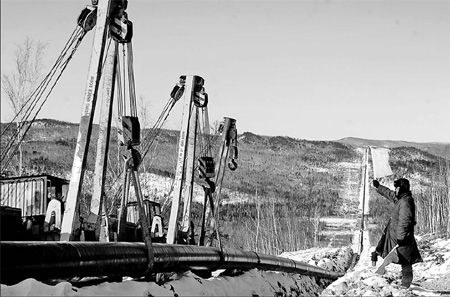 Workers brave the freezing cold to build the Russia-China oil pipeline linking Skovorodino and Daqing. [Zhao Jianzhong / Xinhua]
Workers brave the freezing cold to build the Russia-China oil pipeline linking Skovorodino and Daqing. [Zhao Jianzhong / Xinhua]
http://www.chinadaily.com.cn/china/2010-03/22/content_9619799.htm
Scovorodino is on the Transiberian Railway, at km 7275 from Moscow
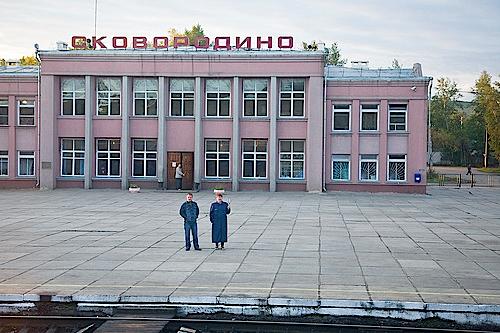 http://aroundguides.com/Skovorodino
http://aroundguides.com/Skovorodino
But total Russian exports will end sometime between 2020 and 2030 according to this assessment using the Hubbert linearization method and assuming a modest domestic demand increase:
A quantitative assessment of future net oil exports by the top 5 net oil exporters
by Jeffrey J. Brown and Samuel Foucher
This is the Russian oil production and export graph
Oil, geopolitics and debt. Who connects the dots?
